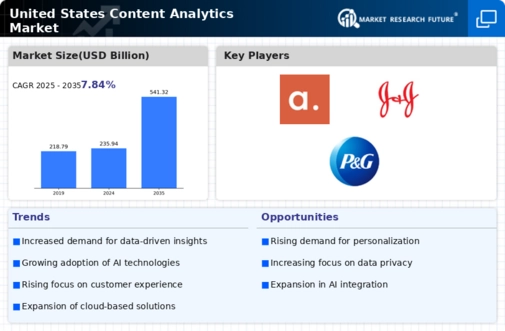The content analytics market is currently characterized by a dynamic competitive landscape, driven by the increasing demand for data-driven decision-making and the proliferation of digital content. Major players such as Google (US), IBM (US), and Microsoft (US) are at the forefront, leveraging their technological prowess to enhance their offerings. Google (US) focuses on integrating AI capabilities into its analytics tools, aiming to provide deeper insights and predictive analytics. IBM (US) emphasizes its cloud-based solutions, facilitating seamless data integration and real-time analytics, while Microsoft (US) is enhancing its Power BI platform to cater to a broader audience, thus fostering a more inclusive analytics environment. Collectively, these strategies indicate a shift towards more sophisticated, user-friendly analytics solutions that cater to diverse business needs.
In terms of business tactics, companies are increasingly localizing their operations to better serve regional markets, optimizing supply chains to enhance efficiency. The competitive structure of the market appears moderately fragmented, with numerous players vying for market share. However, the influence of key players remains substantial, as they set industry standards and drive innovation. This competitive interplay fosters an environment where smaller firms can thrive by offering niche solutions or specialized services.
In October 2025, Google (US) announced the launch of its new AI-driven content analytics tool, designed to provide businesses with real-time insights into consumer behavior. This strategic move is significant as it positions Google (US) to capture a larger share of the market by addressing the growing need for immediate data analysis, thereby enhancing customer engagement and retention strategies. The integration of AI into their analytics suite is likely to set a new benchmark for competitors.
In September 2025, IBM (US) expanded its partnership with a leading cloud service provider to enhance its analytics capabilities. This collaboration aims to streamline data processing and improve the scalability of its analytics solutions. The strategic importance of this partnership lies in its potential to offer clients more robust and flexible analytics tools, which could significantly enhance IBM's competitive edge in the market.
In August 2025, Microsoft (US) unveiled a series of updates to its Power BI platform, incorporating advanced machine learning features. This development is crucial as it not only improves the user experience but also positions Microsoft (US) as a leader in the integration of AI within analytics tools. By enhancing its platform's capabilities, Microsoft (US) is likely to attract a wider range of users, from small businesses to large enterprises, thereby solidifying its market position.
As of November 2025, current trends in the content analytics market are heavily influenced by digitalization, sustainability, and the integration of AI technologies. Strategic alliances among key players are shaping the competitive landscape, fostering innovation and collaboration. Looking ahead, it appears that competitive differentiation will increasingly hinge on technological advancements and the reliability of supply chains, rather than solely on price. This shift suggests a future where innovation and customer-centric solutions will dominate the market, compelling companies to continuously evolve their strategies to maintain relevance.














Leave a Comment